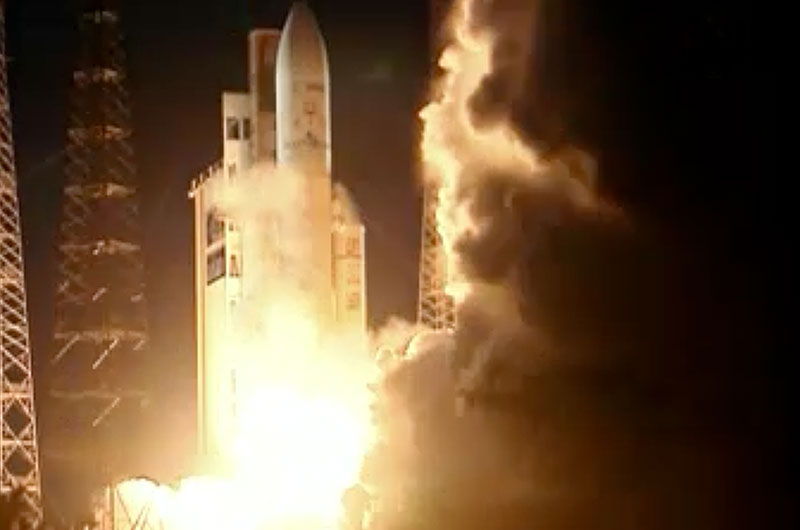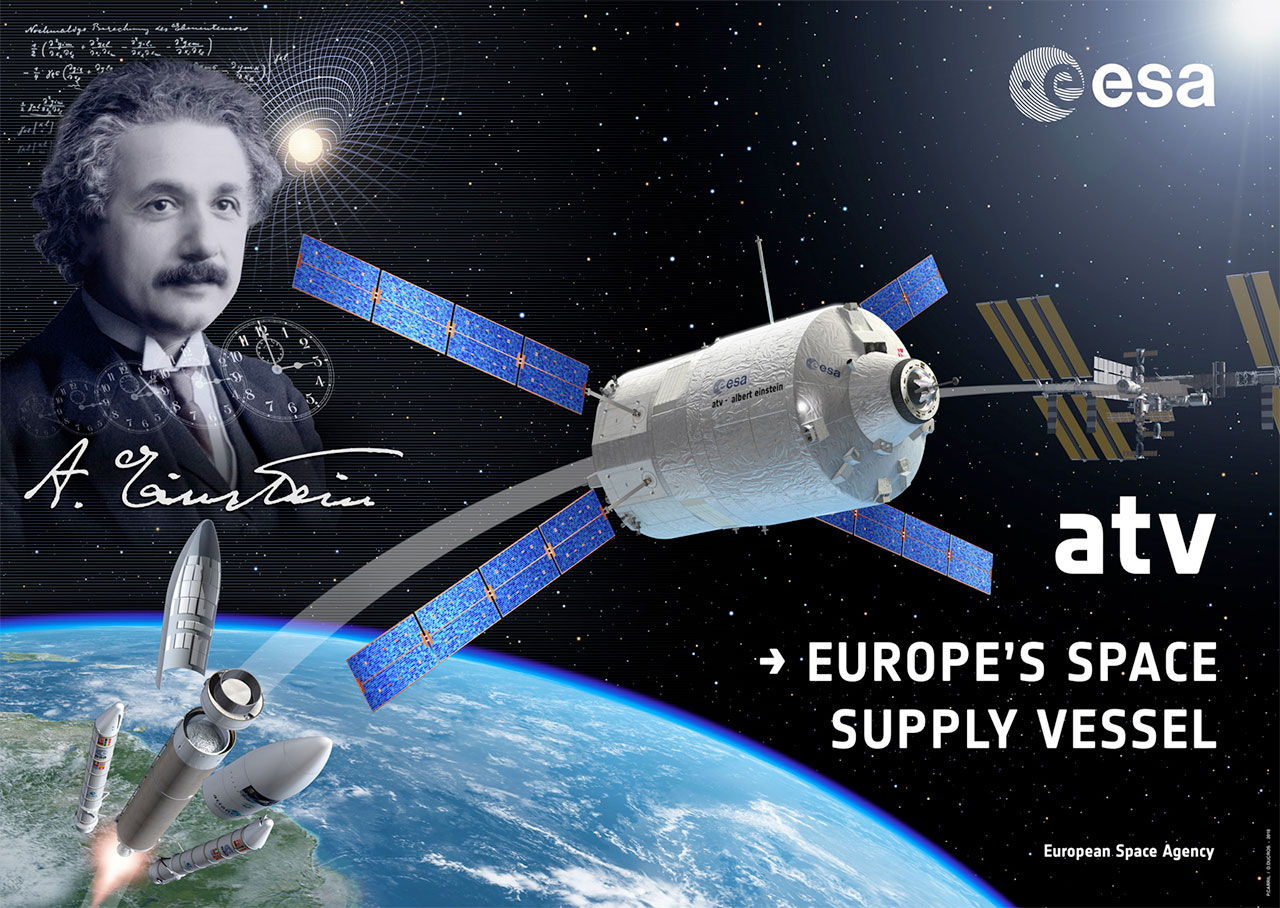'Albert Einstein' in Space: Europe Launches Cargo Spacecraft Named for Scientist

The European Space Agency launched its penultimate mission to the International Space Station on Wednesday (June 5), expending great energy to lift a record amount of mass aboard a spacecraft named for the scientist famous for equating the two quantities with the expression "E=mc^2."
The European Space Agency's (ESA) Automated Transfer Vehicle-4 (ATV-4), an unmanned cargo freighter, lifted off on an Ariane 5 rocket from Europe's spaceport in Kourou, French Guiana at 5:52 p.m. EDT (2152 GMT). The second to last of ESA's five planned station resupply spacecraft launched since 2008, ATV-4 was named "Albert Einstein" after the iconic physicist known for the theory of relativity
Einstein's theorieshave been put to the test in space and his work has guided robotic spacecraft to other planets. ATV-4 is the first spaceship to bear Einstein's name, at the suggestion of the Swiss delegation to the European Space Agency. Einstein was born in Germany but studied and spent his early career in Switzerland. [Einstein Quiz: Test Your Knowledge of the Famous Genius]
Lifting off from the jungle spaceport along South America's northeast coast, ATV-4 soared spaceward with Europe's largest-ever load of dry cargo for the station. Packed with science experiments, crew supplies, a 3D printed tool box and even copies of Einstein's manuscript explaining the foundation for the general theory of relativity, the craft is destined to dock with the orbiting laboratory on June 15.
Ten day trip and traffic delays
The Automated Transfer Vehicle, which is about the size of a London double-decker bus with four solar array wings, has on past missions made the same International Space Station (ISS)-bound trip in half the time.
"The nominal duration from launch to docking is five days to 'phase' or synchronize the orbits of ATV and ISS," said ESA's lead mission director Jean-Michel Bois in a blog on ESA's ATV-4 "Albert Einstein" website. "These five days are a compromise between various constraints, mainly to minimize the propellant consumption."
Breaking space news, the latest updates on rocket launches, skywatching events and more!
Doubling the transfer time for this mission is a combination of traffic on the ground and in space.
"At the beginning, we need to free the Kourou preparation rooms and launch pad as soon as possible to allow [the] launch of numerous other satellites in the year," explained Bois. "With three launchers (Ariane, the Soyuz launcher and Vega), the Kourou logistic situation is complex!"
"At the end (docking), we need to have a free docking port on the space station and must respect several ATV/ISS constraints," he added. The vehicle traffic around ISS and ATV rendezvous constraints allow a docking not before 15 June. This is the explanation of the 10 days."
The docking port where "Albert Einstein" will attach itself to the station is currently occupied by a Russian Progress resupply spacecraft. That vehicle is scheduled to depart next Tuesday (June 11), clearing the aft port of Russia's Zvezda service module for ATV-4's arrival.
ATV-4's laser-guided docking may still be further delayed, depending on what the Progress' departure reveals.
As the Russian craft leaves, the ship's external cameras will focus on navigational sensors on the docking port to confirm that its sensors were not damaged in April when the Progress approached the space station with one of its navigational antennas stuck against its side. The sensors are required for ATV-4 to dock properly.
If there is damage that would prevent ATV-4's arrival, the station crew will go on an unplanned spacewalk to replace the sensors, NASA's station managers said. [Photos: Europe's ATV Robotic Space Cargo Ships]
Seven tons of supplies
ATV-4 "Albert Einstein" and its cargo have set a number of records for Europe, including the aforementioned most dry cargo launched, as well as the most diverse cargo at more than 1,400 different items, and the heaviest ship ever lifted by an Ariane rocket.
In total, the 13-ton space freighter is delivering seven tons of supplies for the space station.
The cargo includes science experiments to be conducted by Luca Parmitano, an ESA astronaut who arrived aboard the orbiting laboratory in late May for a five month stay. His science investigations include a study of emulsions, or suspended droplets in a liquid, and a strict space food diet designed to learn how to feed the astronauts flying on future missions to Mars.
On the flip side, the ATV is also delivering a selection of Italian space food delicacies, including tiramisu, as part of the "crew choice" meal items picked out by Parmitano to share with his Expedition 36 and 37 crewmates.
Also aboard "Albert Einstein" is an empty toolbox and the tools destined to go inside it. The box, which was created using a 3D printer, was too fragile to launch with its tools pre-packed, so the astronauts will have a puzzle-of-sorts to assemble once it's on orbit.
ATV-4 will deliver spare parts for the station too, including a new water pump and recycling unit, a GPS antenna for Japan's Kibo laboratory module and new gas masks to be donned by the crew in the rare case of a fire. The cargo craft also carries water, oxygen and propellant for the ISS, the latter to be used to boost the outpost's orbit around the Earth.
"Albert Einstein" is the fourth out of five ESA Automated Transfer Vehicles. All were named after famous European science figures, including Jules Verne, Johannes Kepler, Edoardo Amaldi and Georges Lemaître.
Click through to collectSPACE.com to see a copy of Albert Einstein's paper "Grundlagen der allgemeinen Relativitätstheorie" ("The Foundation of the General Theory of Relativity”) that is flying on ATV-4 to the International Space Station.
Follow collectSPACE.com on Facebook and on Twitter at @collectSPACE. Copyright 2013 collectSPACE.com. All rights reserved.

Robert Pearlman is a space historian, journalist and the founder and editor of collectSPACE.com, a daily news publication and community devoted to space history with a particular focus on how and where space exploration intersects with pop culture. Pearlman is also a contributing writer for Space.com and co-author of "Space Stations: The Art, Science, and Reality of Working in Space” published by Smithsonian Books in 2018.
In 2009, he was inducted into the U.S. Space Camp Hall of Fame in Huntsville, Alabama. In 2021, he was honored by the American Astronautical Society with the Ordway Award for Sustained Excellence in Spaceflight History. In 2023, the National Space Club Florida Committee recognized Pearlman with the Kolcum News and Communications Award for excellence in telling the space story along the Space Coast and throughout the world.


